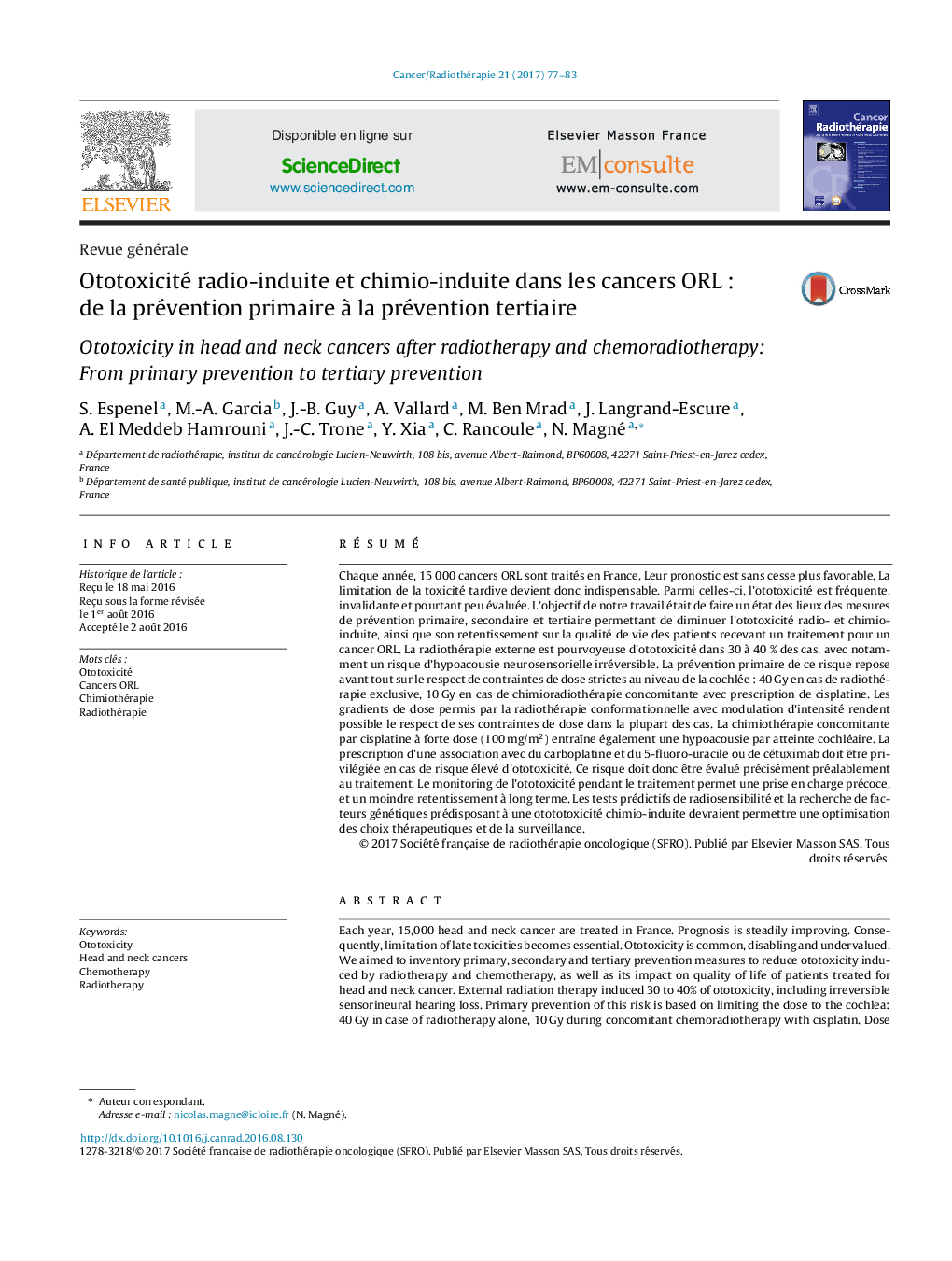| Article ID | Journal | Published Year | Pages | File Type |
|---|---|---|---|---|
| 5525950 | Cancer/Radiothérapie | 2017 | 7 Pages |
RésuméChaque année, 15 000 cancers ORL sont traités en France. Leur pronostic est sans cesse plus favorable. La limitation de la toxicité tardive devient donc indispensable. Parmi celles-ci, l'ototoxicité est fréquente, invalidante et pourtant peu évaluée. L'objectif de notre travail était de faire un état des lieux des mesures de prévention primaire, secondaire et tertiaire permettant de diminuer l'ototoxicité radio- et chimio-induite, ainsi que son retentissement sur la qualité de vie des patients recevant un traitement pour un cancer ORL. La radiothérapie externe est pourvoyeuse d'ototoxicité dans 30 à 40 % des cas, avec notamment un risque d'hypoacousie neurosensorielle irréversible. La prévention primaire de ce risque repose avant tout sur le respect de contraintes de dose strictes au niveau de la cochlée : 40 Gy en cas de radiothérapie exclusive, 10 Gy en cas de chimioradiothérapie concomitante avec prescription de cisplatine. Les gradients de dose permis par la radiothérapie conformationnelle avec modulation d'intensité rendent possible le respect de ses contraintes de dose dans la plupart des cas. La chimiothérapie concomitante par cisplatine à forte dose (100 mg/m2) entraîne également une hypoacousie par atteinte cochléaire. La prescription d'une association avec du carboplatine et du 5-fluoro-uracile ou de cétuximab doit être privilégiée en cas de risque élevé d'ototoxicité. Ce risque doit donc être évalué précisément préalablement au traitement. Le monitoring de l'ototoxicité pendant le traitement permet une prise en charge précoce, et un moindre retentissement à long terme. Les tests prédictifs de radiosensibilité et la recherche de facteurs génétiques prédisposant à une otototoxicité chimio-induite devraient permettre une optimisation des choix thérapeutiques et de la surveillance.
Each year, 15,000 head and neck cancer are treated in France. Prognosis is steadily improving. Consequently, limitation of late toxicities becomes essential. Ototoxicity is common, disabling and undervalued. We aimed to inventory primary, secondary and tertiary prevention measures to reduce ototoxicity induced by radiotherapy and chemotherapy, as well as its impact on quality of life of patients treated for head and neck cancer. External radiation therapy induced 30 to 40% of ototoxicity, including irreversible sensorineural hearing loss. Primary prevention of this risk is based on limiting the dose to the cochlea: 40Â Gy in case of radiotherapy alone, 10Â Gy during concomitant chemoradiotherapy with cisplatin. Dose gradients allowed by intensity-modulated radiotherapy help respecting these limits. Concurrent chemotherapy with high dose cisplatin (100Â mg/m2) also causes hearing loss by cochlear damages. Prescription of carboplatin-5-fluorouracil combination or cetuximab should be preferred in case of high risk of ototoxicity. This risk must be precisely evaluated before treatment. Ototoxicity monitoring during treatment allows early management, and lower long-term impact. Radiosensitivity predictive tests and research of genetic factors predisposing to chemo-induced ototoxicity should enable optimization of therapeutic choices and monitoring.
